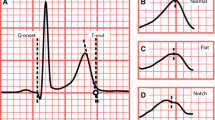Abstract
Measurements were made in 12 normal subjects and during induction ofsustained ventricular tachyarrhythmias in 31 patients with remote myocardialinfarction. QT interval measurements were made semiautomatically withcomputer assistance and the total QT interval was divided into early (QT 1 )and late (QT 2 ) components. QT intervals and QT interval dispersion betweentwo right ventricular endocardial sites were plotted against the degree ofprematurity of the last extrastimulus (S 2 , S 3 , or S 4 ). In the controlgroup, total QT and QT 1 intervals shortened with increasing prematurity ofthe last extrastimulus (p , 0.001). Slopes (positive) were steeper withfaster pacing rates (600, 500, or 400 ms) and more extrastimuli (1 to 3).The relationship between QT 2 intervals and prematurity of the lastextrastimulus was flat, but the slope was slightly negative (p=0.05to,0.001) and did not vary with changes in pacing cycle length or number ofextrastimuli. QT interval dispersion in the control group was minor(95% CI 0-40 ms). During induction of sustained ventriculartachyarrhythmias, total QT and QT 1 intervals were longer (y intercepts)than in the control group (p , 0.05 at 400-ms pacing cycle length) and theirdispersion was increased (p , 0.05). Generally, QT 2 intervals were shorter(p , 0.05 at 600-ms pacing cycle length) during induction of ventriculararrhythmias in comparison with the control group but dispersion wasincreased (p , 0.05 at 400-ms pacing cycle length). QT intervals and QTinterval dispersion show an orderly and predictable relationship withprematurity of the last extrastimulus in normal subjects. These patternsdiffer during induction of sustained ventricular tachyarrhythmias. Suchdifferences may be exploited to derive clinically predictive and usefulmeasurements.
Similar content being viewed by others
References
Horowitz LN, Josephson ME, Farshidi A, Spielman SR, Michelson EL, Greenspan AM. Recurrent sustained ventricular tachycardia 3. Role of the electrophysiologic study in selection of antiarrhythmic regimens. Circulation 1978;58:986–997.
Mason JW, Winkle RA. Electrode-catheter arrhythmia induction in selection and assessment of an antiarrhythmic drug therapy for recurrent ventricular tachycardia. Circulation 1978;58:971–985.
Gillis AM, Wyse DG, Duff HJ, Mitchell LB. Drug response at electropharmacologic study in patients with ventricular tachyarrhythmias: The importance of ventricular refractoriness. J Am Coll Cardiol 1991;17:914–920.
Saumarez RC, Camm AJ, Panagos A, et al. Ventricular fibrillation in hypertrophic cardiomyopathy is associated with increased fractionation of paced right ventricular electrograms. Circulation 1992;86:467–474.
Hii JTY, Wyse DG, Gillis AM, Duff HJ, Solylo MA, Mitchell LB. Precordial QT interval dispersion as a marker of torsade de pointes. Disparate effects of class 1a antiarrhythmic drugs and amiodarone. Circulation 1992;86:1376–1382.
Barr CS, Naas A, Freeman M, Lang CC, Struthers AD. QT dispersion and sudden unexpected death in chronic heart failure. Lancet 1994;343:327–329.
Gillis AM, Traboulsi M, Wyse DG, Duff HJ, McDonald M, Mitchell LB. Dispersion of ventricular repolarization predicts antiarrhythmic drug response (abstr). Circulation 1993;88:I–395.
Mitchell LB, Duff HJ, Wyse DG. Programmed electrical stimulation studies for ventricular tachycardia induction in man. I. The role of functional refractoriness in tachycardia induction. J Am Coll Cardiol 1986;8:567–575.
Millar C, Kralois F, Lux R. Correlation between refractory periods and activation-recovery intervals from electrograms: Effects of rate and adrenergic interventions. Circulation 1985;72:1372–1379.
Lotus 1-2-3, Version 2.2, Lotus Development Corp, Cambridge, MA, 1985.
Fig. P, Version 6.0a, Fig. P Software Corporation, Durham, NC, 1991.
PCInfo, Version 1.0, Retriever Data Systems, Seattle, WA, 1989.
Task Force of the Working Group on Arrhythmias of the European Society of Cardiology: The Sicilian Gambit. A new approach to the classification of antiarrhythmic drugs based on their actions on arrhythmogenic mechanisms. Circulation 1991;84:1831–1851.
Shimoni Y, Clark R, Giles W. Role of an inwardly rectifying potassium current in rabbit ventricular action potential. J Physiol 1992;448:709–727.
Hart G. Cellular electrophysiology in cardiac hypertrophy and failure. Cardiovasc Res 1994;28:933–946.
Tomaselli GF, Beuckelmann DJ, Calkins AG, et al. Sudden cardiac death in heart failure: The role of abnormal repolarization. Circulation 1994;90:2534–2539.
Aronson RS. Mechanisms of arrhythmias in ventricular hypertrophy. J Cardiovasc Electrophysiol 1991;2:249–261.
Beuckelmann DJ, Naebauer M, Erdmann E. Alterations of K+ currents from patients with terminal heart failure. Circ Res 1993;73:379–385.
Wettwer E, Amos GJ, Posival H, Ravens U. Transient outward current in human ventricular myocytes of subepicardial and subendocardial origin. Circ Res 1994;75:473–482.
Naebauer M, Beuckelmann DJ, Ueberfuhr P, Steinbeck G. Regional differences in current density and rate-dependent properties of the transient outward current in subepicardial and subendocardial myocytes of human left ventricle. Circulation 1996;93:168–177.
Bogun F, Chan KK, Harvey M, et al. QT dispersion in non-sustained ventricular tachycardia and coronary artery disease. Am J Cardiol 1996;77:256–259.
Yuan S, Blomstrom-Lundquist C, Pripp C-M, Pherson S, Wohlfart B, Olsson SB. Dispersion of repolarization and the induction of ventricular arrhythmias. A clinical study using the monophasic action potential recording technique. PACE 1996;19:II728.
Glancy JM, Garratt CJ, Woods KL, DeBono DP. Three-lead measurement of QTc dispersion. J Cardiovasc Electrophysiol 1995;6:987–992.
Author information
Authors and Affiliations
Rights and permissions
About this article
Cite this article
Wyse, D.G., Mitchell, L.B., Sheldon, R.S. et al. Divergence of Endocardial QT Interval Components during Programmed Electrical Stimulation Including Observations during Induction of Sustained Ventricular Tachyarrhythmias. J Interv Card Electrophysiol 1, 23–31 (1997). https://doi.org/10.1023/A:1009706516217
Issue Date:
DOI: https://doi.org/10.1023/A:1009706516217




